The Hardrock 100 Experience
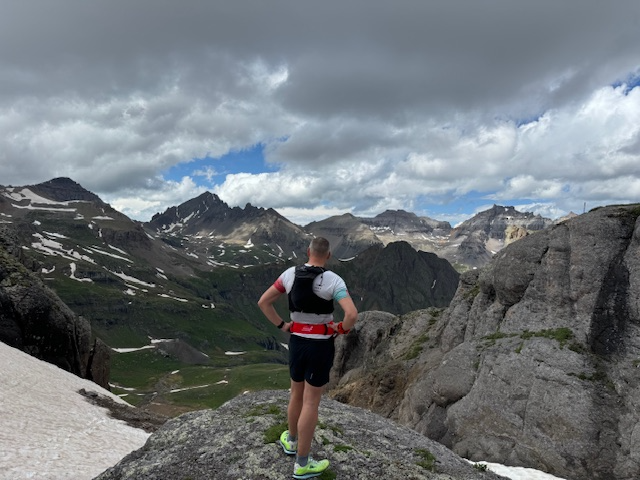
The Hardrock 100 is one of the iconic 100 mile trail races in the United States. Along with Leadville and Western States, it attracts some of the top names in international Pro-trail running together with mere mortals, who nonetheless still put in endless hours of training.
The course is large loop in the San Juan Mountains in South-Western Colorado. The direction alternates each year clockwise or anti-clockwise. It has a total elevation of approximately 33,000 feet, an average elevation of 11,186 feet. The highest point on the course is at the summit of Handies Peak at 14,048 feet, one of Colorado’s so called 14’ers.
In comparison, Leadville 100 has only 18,000 feet of elevation gain and the Western States 100 has a mere 16,959 feet of elevation, half of the Hardrock Experience.
As we shall find out,trying to get a place in the race seems to be more difficlt than actually running with only 146 places allocated from a ballot of several thousand applicants.
Derek Fish was one of four british athletes in the field this year. He belives he is only the second Scottish athlete to have competed at hard rock
We caught up with Derek for a chat
How did it all start?
AS. I think most of the people reading this will know your background, but some won’t. Briefly tell us how you got into running.
DF. Alcohol.
AS. Okay, good enough. Would you like to elaborate?
DF. A bunch of us were on a Christmas night out, and one person had signed up for the Edinburgh Marathon and encouraged us at the table to sign up the other three guys. So, we ended up signing up for it.
That was the 2013 Edinburgh Marathon. So that would be Christmas 2012. I ran that in 3 hours and 52 minutes. Then, the following year, a friend asked me if I wanted to do the London Marathon for the Anthony Nolan Trust. He had donated bone marrow. So, with London being a month earlier, I decided to join a running club to try and motivate myself through the winter and ended up at the Wee County Harriers, first of all, just down the road from my work. So that’s the start. I did a few Park Runs before the marathon. The first one was 28 minutes 52, I think.
AS. As a bit of a stat geek, I look all these things up, and I see you got led astray to do an ultra in 2014 for the first time.
DF. Yes. After the London Marathon, in 2014, I did the Clydestride that year and then Glen Ogle.
NOTE Clydestride is an approximate 40-mile course from the centre of Glasgow along the Clyde to New Lanark. Glenogle 33, or GO 33, is run on undulating beautiful trails from Killin in Perthshire down into Glenogle and back
AS. So it all went pearshaped from there and you got led astray.
DF. Yes. So the Clydestride was held later than its usual July slot that year because of the Commonwealth Games. A couple of guys at the club were doing the Highland Fling and took me running in the hills and up the West Highland Way on some of their training runs. It’s never stopped from then on.
AS.Your’re following in a strong tradition. Before your running career, shall we say, did you do any sport at school or through your formative 20s?
DF. NO. Well, I was a scratch golfer when I started running. I’ve since packed it in because you don’t have time to do everything. Prior to that, I played a bit of football. But golf was my mid-20s thing. I just got right into golf and played a wee bit. I’m probably a better golfer than I am a runner. Or at least I was, but not anymore.
AS. You gradually gravitated to longer events. You did three West Highland Ways.
DF. I did the West Highland Way in 2016, 2017, and 2018.
In 2019, one of my best mates got married on the day of the race. So I ended up doing the South Downs 100 later that year. Then I had places in 2020 and 2021, but COVID cancelled them.
So, that was unfortunate, but you never know. I might try and get below that 20-hour barrier yet. It will have to wait a few years though.
AS. You have run some longer, harder, races, like Ultra Tour de Monterosa, which although only 100 miles, you can be out for over two days. So it’s a tough course.
DF.Yeah. That’s probably one of the hardest I would say.
AS. You have also run UTMB and run the East Highland Way, and West Highland Way in one go, which is getting into the realms of multi-days, along with the Swiss Peaks 360
and the incredibly challenging Tour de Géants. So you’re building up a huge endurance base over the years and getting out on your feet for four or five days at a time
For those that don’t know, I know you’re very close to finishing your Monro’s. How has your Monro’s journey coincided with your ultra training or ultra racing, and how are the two compatible? Do you think that they help each other.
NOTE: For those who don’t know, The Munro’s are all the Scottish Mountains over 3,000 feet, 282 of them. Bagging Munro’s, either singly or in groups, can involve long days in the hills with several thousand feet of ascent and descent.
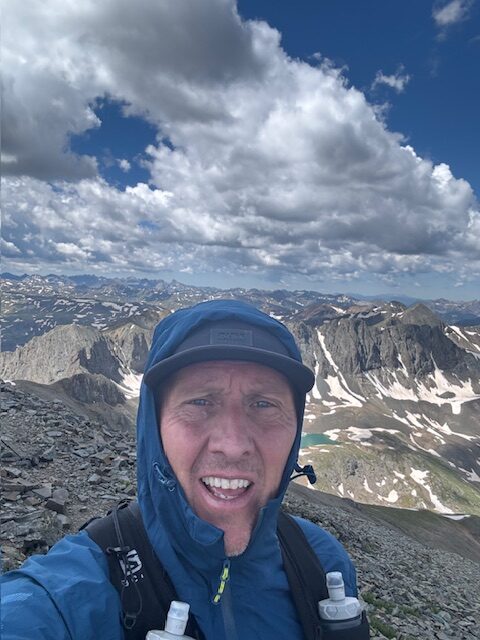
DF. Certainly. I think that one of the things I enjoy, Adrian, is getting out in the hills for big days. I get coached by Paul Giblin, who is constantly telling me, “You out again? I put five hours in the schedule, and you’re out for 12 hours!”
I like planning routes, ticking off Munro’s and linking things together that most people wouldn’t normally do. My Dad is a Monroeist, and he’s walked the West Highland Way self-sufficient three times. I did a lot of hills when I was a kid, maybe about 32 Munros, a lot of them two or three times over because we used to go on holiday up north and do the same ones. I think the running coincided with me being at an age where I got the bug back for getting back out on the hills.
AS. Leaving aside what Paul is bending your ear about, do you feel these long big days in the hills with big climbs, are beneficial to you as an ultra-runner?
DF.Yeah, absolutely. I think being self-sufficient in the hills in Scotland can be more challenging than in the Alps, at times, just with the weather and looking after yourself and even route planning and contingencies and so on. It is a good grounding into some of the longer Alps stuff. Finding people daft enough to go with you sometimes is quite challenging. So maybe half the time I’m out on my own, but you know, I’ve got a good bunch of friends, and we try and hook up and get some of them done together. I quite enjoy the whole planning aspect of getting them done, doing the research, making GPX files up and putting them on my watch.
AS. As you say, it also builds that resilience so that when you’re out doing a long race, you know, you’re thinking on your feet. You’ve had all the experiences and been through them all in your training.
DF. Absolutely. Getting lost is one that I wouldn’t like to replicate in a race, mind you. But yes, it happens.
Hardrock 100 on the radar.
AS. Moving on, when did Hard Rock first appear on your radar?
DF. Well, it was probably after I did UTMB in 2019. You watch a lot of stuff on YouTube, and you read about it with the global superstars, and I think I put an entry into the ballot about 2021. I actually could have put one in before, with Monte Rosa as a qualifier for a couple of years and UTMB for a couple of years. Because you get two years of qualification for the race, you can apply for two years in a row with it. But I think 2021 was my first time applying, and bearing in mind the average time to get into Hard Rock is ten years, I think I got lucky getting in so quickly,
Entry to Hardrock 100
AS..So when do you hear you’ve been accepted? What is the timescale between applying and getting accepted and then thinking, “Oh my
gosh, I’ve got to actually train for this now?”
DF. So, the Hardrock draw is made on the same day as the Western States draw. I think it was about the 2nd of December. I have had seven years now trying to get into the Western States as well, but I didn’t have a qualifier last year, so I didn’t consider anything and wasn’t paying attention on the day of the ballots.
A friend called Colin Anderson messaged me to let me know that I had got into Hardrock. He has been trying to get into the Western States for several years and was watching both draws live on YouTube. His message was something like I didn’t get into the Western States again, along with a few swear words. Then he added, “But you have got into Hardrock.’
That came as a bit of a shock. I booked my accommodation quite quickly, the very next day, on the 3rd of December, because it’s such a small place, and it’s hard to get accommodation. So I got in there quite quickly and was quite organised.
AS. You said that it takes about ten years on average to get into Hardrock. Do you know how many people are in the ballot in any one year?
DF. They split the draw 50-50 for the 146 places. There were 73 places allocated for first-timers, and there were over 9,500 mail entrants for 73 spaces. I think my winning lottery ticket number was 33,000 and something. So, yeah, it was like one of 50,000 tickets or something like that.
Silverton. Hardrock 100 base camp!
AS. The Hardrock 100 starts in a little place called Silverton.
Try and paint a picture of Silverton. How big is it? Is it as big as somewhere like Tyndrum or Drymen? Smaller or bigger? Or just a one-street town somewhere in the boonies where everyone just congregates?
DF. Silverton’s an old mining town, as you can imagine. It originally started as a silver area, and it progressed to iron ore. I was told that there were 752 residents at the race briefing. It has one tarmac Main Street and several dirt offshoots from there. It gets pretty busy in the summer, especially around the 4th of July. Jeep safariing and off-road jeep stuff are the main interests in the area, along with hiking. You can get jeeps up to 13,000 feet, and some roads go up to the tops of peaks at 13,500 feet. There are tracks built all the way up. It is a very oldie world, and it looks like something out of a Western at first sight, but when you go in, the buildings are a mixture of traditional wood and a few stone ones. It’s a very original, authentic Western.
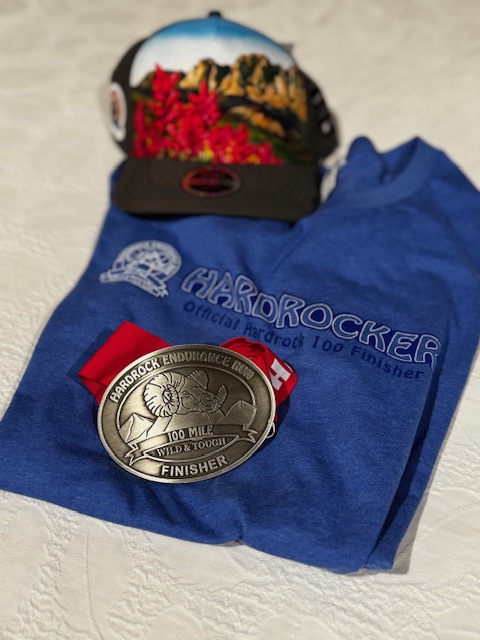
Acclimatising
AS. How long did you go out before the race?
DF The race starts on a Friday. We went out 13 days before, myself and Gavin, to try and acclimatise to the altitude. One of the chaps, Chris Twiggs, who’s a board member of Hard Rock, and a 17-time finisher, organises the recce runs for visitors. We missed the first couple, which started on Thursday the previous week, but we got along to three or four of the recce runs with them and met a bunch of about 18 people who were there doing a similar thing. We did all the main climbs up to the very top. We went up Grant Swamp Lake. Every day it was getting hotter. We did a good few of the big climbs, all at a very easy pace.
AS. You’ve run in the Alps at altitude. At Hardrock, you go up over 14,000 feet. Have you been as high as that before in the Alps?
DF. I think the highest I had been before was just over 10,500 feet.
The average height for hard rock is 11,000 feet. It drops to about 8,500 feet at Uray. The highest point is 14,048 feet at the summit of Handys Peak.
Before we went out, we went to the University of the West of Scotland, in Glasgow, which has an altitude chamber. We went and tried it out, and we did five sessions, although I ended up being ill and missing the last two. We increased the altitude every time we went. It was very interesting. He said that it would not, in any way, acclimatise you to it at all, but that you would understand how your body would react to it. Some people almost pass out. But both myself, Gavin and Greig seemed to cope quite well with the rigid steer. I was just on the bike at the time, had a knee injury and was kind of nursing it, but the treadmill was quite an experience for the guys trying to run.
NOTE. Gavin Bussey and Greig Stevenson were Derek’s trusty support crew, along with Zara Malley, Derek’s girlfriend.
Gavin travelled out with Derek, and Zara and Greig went out a week before the race.
AS. So, in the race itself. It seems you could be met at some checkpoints, but not others. I’m imagining the checkpoints are pretty much right out on the boonies. Did Gavin, Greg and Zara manage
to meet you at all the places you wanted them to?
DF. YES. So there are four main towns that it goes around. The biggest problem is that we were doing the race clockwise. There is one at Lake City, which is the Sherman aid station. A lot of access to the aid stations is up Land Rover tracks, and you need a high-clearance vehicle. The one round at Sherman was where you had to go over the Cinnamon Pass. We did it in the daylight, but nobody wanted to do it in the dark. The alternative is a five-hour drive all the way around and then a five-hour drive back. We just put a drop bag in there for that. You are allowed pacers, and we adapted the pacing strategy.
There were three changeovers, so we were going to do a leg each—a leg, then a rest, then Gavin did a big 30-odd mile stretch before Greg did the 9-10 miles at the end.
It meant that they could go and get a sleep in between, and could go back to the motel and chill out for a wee while. It worked out quite well.
AS. Do most of the runners have pacers at certain times?
DF. You can do it self-supported if you want to. You can also virtually go there to the race briefing, and there’ll be people shouting, “Does anybody need a pacer?” There are people just desperate to be there and help. There was a chap called Stephen Scobie who was born in Dumbarton. He lives in London but works in New York. He claims to be Scottish but not for the World Cup or the Euros because he was brought up in England for most of his life. He managed to spontaneously get a pacer to come with him for the last 25 miles or so. So yes, people offer their support. They just want to be involved in the race.
AS. Compared with other races you’ve done, would you say you’re getting a pretty genuine wilderness experience?
DF. Absolutely.
AS. I remember, chatting with Jasmin ( Jasmin Paris )and others, that at races like UTMB, even like two in the Morning on top of a mountain, there’s often someone there with an accordion or a cowbell, cheering you on, but when you do things like Barkley or in your case Hardrock, there’s no one. You might not see anyone for hours, yeah?
DF. Yes, I mean, it’s pretty sparse. There are a lot of hikers out up in some of the passes, but there are certainly long stretches during the night where there is nobody about. It was quite bunched at the start and it was quite bunched at the end, but that was because I was catching people up. There are only 164 people, so it’s easy to spread out quite quickly.
AS. Having mentioned UTMB, let’s talk entry numbers. You’ve run many ultras and run in some very busy races. UTMB this last year had 1,800 finishers in the main 100 miler. Plus a few thousand in the supporting races!
The Western States in 2024 had 300. Hard Rock only had 119 finishers. Way, less entries than even our” Iconic Scottish 100″ West Highland Way which had 179 finishers in 2024 from 219 starters.
DF. You know the thing that I find so funny about it is that because it’s in a National Park they restrict the number of runner entries on the grounds of conservation. Yet you’ve got buggy tracks that go up really high. You could drive a 4×4 up to 13,000 feet on a road.
It’s just because, a bit like the Western States, they’ve capped it at what the original permit was and it has just stayed like that
There are more volunteers than runners each year as People just want to be involved in it and they come back year after year to help.
AS> We get that. We get volunteering. It’s a thing, isn’t it?
DF. That’s actually one of the conditions of entry. You have to do eight hours of service, path building at a national park or volunteering at a race. You’ve got to do eight hours and get a form signed and send it to them by a certain date. I spent a lovely day on Ben Lomond, one of the hottest days of the year, doing path repairs. Fabulous. I went out the next day to do my long run on the Sunday and it lashed the rain from the second I left the house until two in the morning. It was terrible weather. But yeah, I did that. I did some marshalling, at the Caterun trail for a bit.
AS. It’s a good ethos. I mean, we’re not short of volunteers at most of the races I’m involved with, but it’s a good ethos.
DF. It was great fun doing the path building. So many people stop and speak to you ask questions, and say, “Thank you.” Carrying a pickaxe, 2000 feet up a hill isn’t so much fun either.
AS. Was there ever any point where you doubted you would finish?
DF. This is probably the least fit I’ve ever been going into a big race. I had a couple of niggles with my knees and a weak quad, and I ended up with norovirus the week before I flew out. So I hadn’t run for about four weeks before I went out, which wasn’t great. I knew I was going to be slower than normal, and probably mid-to-back of the pack. I think it was just a case of go and enjoy a classic race. In the runners’ manual, they give you a 48-hour pace plan based on the average time of people finishing. In the first half of the race, I was behind that 48-hour schedule all the time. I would not say I panicked, but it made me more efficient at getting in and out of checkpoints and not hanging about too much. Then we got to what must have been the Sherman aid station, at around 70 miles, and I realised that I was up on the schedule. Almost an hour up. Then, with every checkpoint we went through, I got a wee bit more ahead. You know, 15 minutes became half an hour up, and the panic started to calm. I recall we had two last section sections to do. One with 1,800 feet of climbing, and it was nine miles. The schedule gave you four hours to do that. The next section was 2,800 feet of climbing, and it was six miles. They said it would take four and a half hours to do that. I am sitting there with 10 hours to go, thinking this is doable. I managed to make a decent time. I made up time on what I was predicting in the second half of the race. When I got to the last aid station, I had six hours to finish the race. The guy said, “The fastest anybody’s ever done it from this position, was two hours to the top, two hours to the bottom. I made up in 1.53, and unfortunately, my quad started to go on the way downhill, so it took me two and a half hours to get down. It was just a jog, walk, kind of progress at the end, but yeah, the only thing that could go wrong was breaking an ankle or something at that point, so I just used the time I had to make sure I finished it. It was about 3 or 4 in the morning by that point, so well into the second night, and I was getting quite tired.
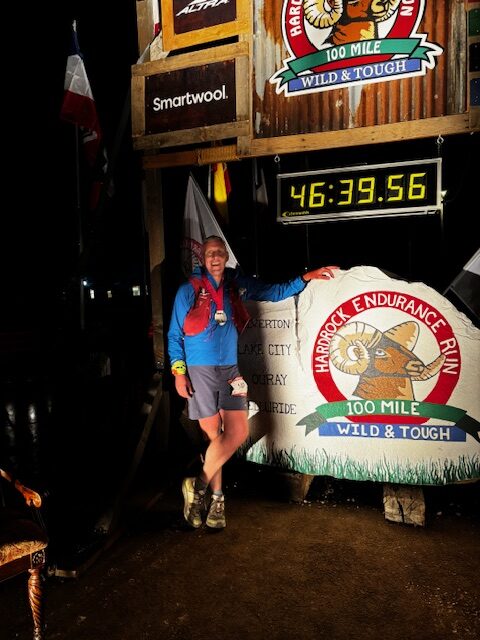
AS.What shoes did you wear?
So I wore a pair of VJ Sports Max 2. I only bought them before I went out to the race, which is not to be recommended. I did some of the recce runs in them, and they were a half size too big, which I thought might work out okay. I had bought a smaller size, but they were a wee bit too tight, so I wore the bigger pair. Normally I wear La Sportiva Akasha. There was a lot of scree on the route and a lot of steep descents. There were also a lot of muddy sections to it, so I felt like the more grip was the way forward. They’re great shoes.
British and Scottish Participation
AS. How many british runners ran this year?
DF. There were actually three others. Stephen was, but because he registered from his New York address, he shows up as from New York, but there was another chap called Owen Wainhouse from Dagenham who had done it before and Steven England from Hove. We had been messaging Owen back and forward before we went out. He was unsupported as well. As he was running around me for most of the race, my team were helping him out as well when he came into checkpoints. He was a really nice guy. Unfortunately, he got a wee bit lost in the last section and ended up getting timed out by just under an hour.
AS.Do you know how many Scots have run Hard Rock?
DF. The only other Scottish runner before me, I believe, was Jim Drummond. Jim did it several times.
I knew Jim from other events, and he messaged me and offered me maps, and his notes and everything from his time out there. I had planned to go and see him because I stay in Stirling and he’s in Doune. But I was unwell the week before the race, and I genuinely was in my bed,
I think he’s finished it twice, and he’s been timed out once as well.
He also was able to go out for three months one year. He hiked all over the route and the area.
He told me he had notes from every climb and detailed maps and descriptions of everything.
AS, What’s next for Derek?
DF. Western States.
I’ve had seven years of entry into the lottery for the Western States without success. So, I still want to try and get through the ballot for that. There is also a race I want to do again, which is the Tour de Géants. I am 50 in two years, so not next year but the year after.
I have thought of doing the Triple Crown, which is the three 200-mile ultramarathons in the US.
Another one I was looking at that intrigued me was Fat Dog 120. I’ve never been to Canada.
So, I met the volunteer coordinator out at Hardrock. He was a gnarly old guy who kept mentioning the Fat Dog,
It’s both a Western States and a Hard Rock qualifier. We asked him about the race, and he said, “Look, boys. It’s sort of a race, but if you feel you need a support crew and a cuddle at each checkpoint, don’t bother. You’re out in the wilderness. You’re self-sufficient, and there’s a long way between some very remote checkpoints.”
That has piqued a wee interest in going out to Canada. So possibly that next year as well. I don’t know. So much depends on lotteries for these races, and things are getting harder to get into. I’ve got a place in CCC, which I booked as a backup if I timed out at Hardrock and needed a Western States qualifier. So you’re planning your year ahead with many ifs and maybes.
It’s quite expensive to book races and then cancel them because you don’t get much money back. Certainly not from UTMB.
AS. What keeps you inspired to run?
DF. Somebody else asked me this recently, and people ask why. You’re crazy! Why do you keep doing this? I think there are two main reasons, Adrian. I like going to new places and new mountains and discovering and exploring. You also meet many good people with whom you then keep in touch.
AS. For anyone who has looked at races like Hard Rock, Western States or the other big 100s, would you advise them to keep going and getting in the lottery?
DF. Yes. I think the Americans are very enthusiastic, and they are good at bigging themselves up. At the same time, the number of times I saw guys like Jim Walmsley or Zac Miller walking around, and Dylan Bowman was also there. All these guys are approachable, and you can go up and speak to them all.
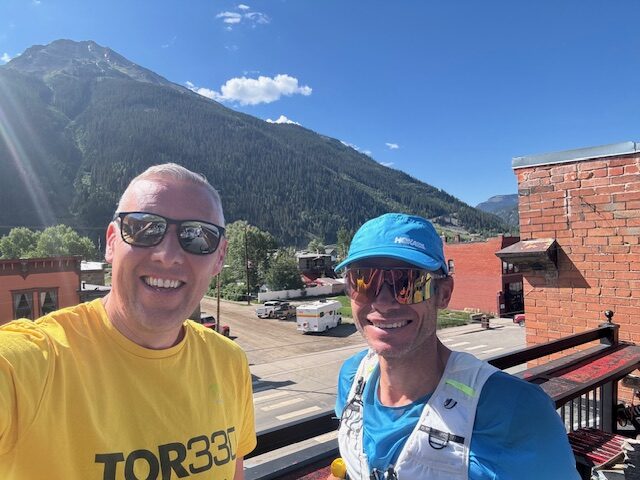
And because it is quite a tight, small race, you see them all the time. It’s a small place. Ludovic Pomeret messaged me to wish me good luck.
I also met Ludo in a coffee shop and tagged him in a photo. He messaged me, and then I messaged him to say congratulations, and he replied, “Well done on your finish.”
So yeah, there’s a lot of great people to meet. Just get your name in the draw. You’ll get drawn out at some point, you’ve just got to keep going. One guy took him 14 years to get into Hard Rock. Two people were 12. So yeah, you’ll get there. My fingers are crossed for the Western States for this year’s ballot. I’ve got a nice belt buckle as a finisher, and that’s taking pride of place now on the mantlepiece.
Footnote: As Derek has mentioned, and you will see from the results link below, Hardrock is very much a race amongst equals, and you against the course, with Derek mixing it with the likes of Ludo, one of the most consistent French International trail runners of the last 10 years and a certain Courtney Dauwalter.
Information on Hardrock 100 and how to enter on the race website
Full results from the 2024 Hardrock 100 HERE
PLEASE SHARE!
Thanks for reading . If you have enjoyed this post, do see our other ones HERE
If you have a comment, please feel free to add it below.
If you are inspired by this or think someone else you know will be, please do what you have to do by sharing. You all know how these things work by now:-) You can also follow me on Twitter and Instagram @tarittweets
Sign up to receive our newsletter alerting you to new posts
Adrian Tarit Stott.
The author is a former GB 24 hour ultra international with over 100 ultra race completions. He has also been involved organising ultra distance races for over 30 years. Still an active recreational runner, he is currently a member of UKA’s Ultra Running Advisory Group (URAG) and part of the selection and team management for both Scottish and GB ultra teams.He is also a freelance writer in his spare time, contributing articles and reports to several websites and magazines including Athletics Weekly and Irunfar.